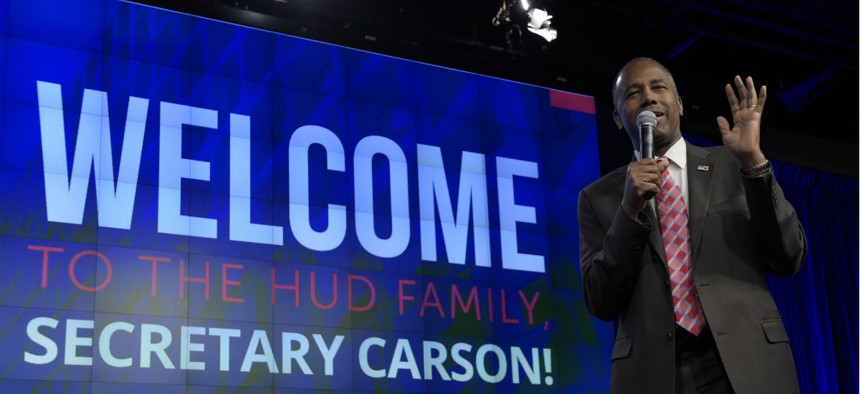
Housing a Urban Development Secretary Ben Carson speaks to HUD employees in Washington on March 6. Susan Walsh/AP
Carson’s Ultimate Goal for HUD: 'Heal the Nation'
Housing and Urban Development Department Secretary Ben Carson gave employees his vision for the agency. He also promised to fix the restrooms at headquarters.
Housing and Urban Development Secretary Ben Carson on Wednesday unveiled his vision for the agency in a town hall meeting with HUD employees, launching what officials are calling a multi-year reform plan. While short on details, the plan is long on ambition: reimagine the way HUD works; restore the American dream; and rethink communities in a more holistic way. The ultimate goal, Carson said, was to "heal the nation."
“You have been blessed with a tremendous opportunity at HUD,” Carson told employees, adding that he accepted the job because he “felt the country was in grave danger of tearing itself apart.” The role of HUD secretary offered him a chance to change that, he said.
Carson and Chief Operating Officer David Eagles outlined the broad strokes of reform at the department’s headquarters in Washington, and HUD permitted two Government Executive reporters to attend.
Eagles said HUD has not yet finalized the plan it must send to the Office of Management and Budget this month, so he could offer few details. However, he said it was not “a cost-cutting exercise,” noting that the agency has experienced significant cuts in recent years. According to data compiled by the Office of Personnel Management, HUD has reduced its workforce by 20 percent since 2003, from more than 10,000 employees to about 8,000 today.
“We don’t know what the final budget numbers are,” Carson said, “but whatever they are we’re going to [spend it] in efficient ways.”
The details of the reform plan will be fleshed out on a website devoted to the effort, allowing employees to “hold us accountable,” Eagles said. The website outlines 10 objectives, several of which relate to improving departmental operations, but also enhancing the safety of public housing, reducing homelessness, and more effectively helping those who need housing assistance. Each of the objectives has a project leader.
Employees were frustrated by the lack of detail during a question and answer session.
When asked if HUD planned to close any field offices, Eagles said: “Certainly that’s not part of the plan. We’re not going to close offices just to close offices.”
“With all due respect, we’re not really hearing too much,” said one union employee. “Will there be forced reassignments?” Carson said there is no long-term plan for more forced reassignments, and Eagles noted they were still “very early in the process.” He pledged to be “very thoughtful, very transparent. I can tell you this is certainly not a [reduction in force] operation.” When pressed about how HUD would handle any future involuntary reassignments or whether staff would be retrained for new positions, Eagles said, “we honestly don’t know yet.”
One potential stumbling block for Carson and Eagles may be the lack of political appointees in place. According to the appointee tracker by the Partnership for Public Service and the Washington Post, only four of 12 key HUD positions—including Carson’s—have been filled. HUD Deputy Secretary Pam Patenaude has been on the job less than a week. Three nominees are awaiting confirmation and a fourth has been announced, but four critical executive positions remain vacant without any nominee on the horizon. And there are dozens of additional vacancies below those top-level posts.
Low morale is another problem. HUD ranked 24th out of 27 mid-sized agencies in the nonprofit Partnership for Public Service’s 2016 ranking of best places to work in the federal government. The findings, based on data collected through OPM’s Federal Employee Viewpoint Survey, showed especially low satisfaction in the areas of employee skills-mission match; training and development; and strategic management.
Eagles said he was encouraged by the most recent FEVS data, which show employee engagement has improved over the last year.
HUD employees definitely like some of what they heard Wednesday. They clapped and cheered loudly when Carson pledged to tackle some of the more immediate problems at HUD headquarters: fixing the restrooms, installing wireless access, putting kitchenettes on every floor (employees lost their cafeteria during previous cost-cutting exercises) and maybe even hanging photos of HUD personnel doing mission-oriented activities.
“When we feel better, we work better,” Carson said. “Then we really can do what we do, and that’s help people in need.”







